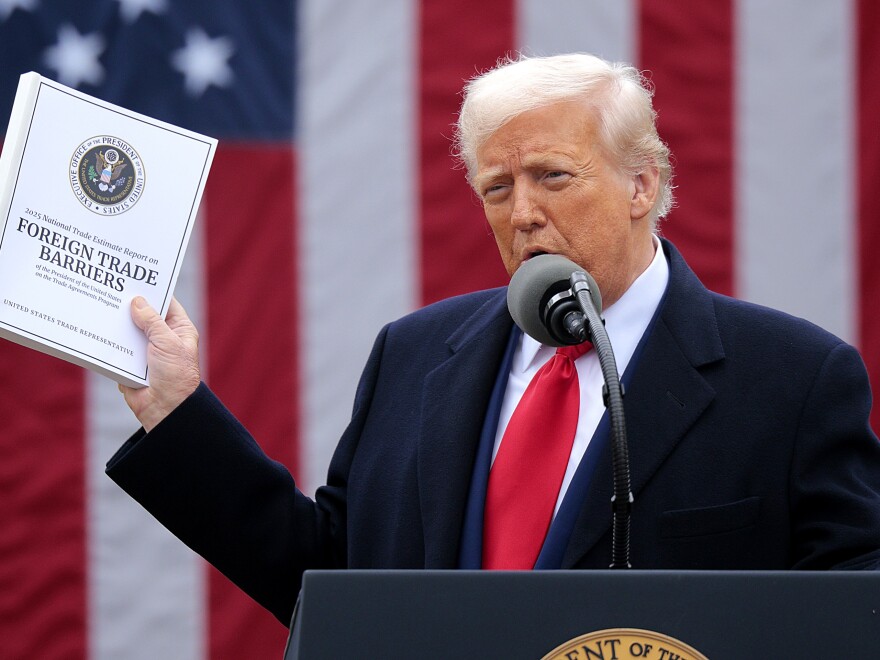Everyone in the nation, from companies to citizens, appears concerned that if President Trump’s huge tariffs go into force this week on August 1, the economy will suffer greatly.
However, anyone who has recently examined their retirement savings or 401(k) statements would have found something unexpected: Stocks are increasing. The tech-heavy Nasdaq and the S&P 500, which represents the largest U.S. corporations, have both recently reached record highs.
What gives, then?
Here are four points to consider, including the reasons why some investors continue to fear a negative outcome.
It’s the economy, stupid
Despite being a cliche that has persisted since Bill Clinton’s 1992 presidential campaign, it nevertheless accurately captures the reasons why investors are pushing stocks to all-time highs.
In spite of worries about the effects of tariffs, the economy has fared far better than most anticipated.
Despite a little increase in inflation to 2.7% in June compared to the same month last year, the economy has not yet experienced the surge in consumer prices that some economists had initially anticipated.
The labor market has also fared well. Because companies aren’t firing employees and employers are generally hiring at a steady pace, the unemployment rate is still at a historically low 4.1%.
Investors are aware.
Brad Peterson, national portfolio manager at Chicago-based financial firm Northern Trust, says, “The economy has proven to be more resilient than many feared in the face of tariff threats.”
However, according to the most recent quarterly survey from The Wall Street Journal, the majority of economists still predict that the U.S. economy will grow more slowly in the second half of this year than it will in 2024, and that the likelihood of a recession within the next 12 months is 33%.
Companies are still reporting decent profits
The other thing that Wall Street investors enjoy is this:Corporate profits are holding up better than many market participants had previously anticipated. Investors appear relieved despite the fact that the results aren’t spectacular.
Businesses that exceeded Wall Street estimates include Hasbro, Netflix, AT&T, and Alphabet (the parent company of Google). Additionally, they seem more upbeat about their outlook. For example, despite the uncertainties around tariffs, Delta Air Line passengers are feeling more confident.
The results show a peculiar mismatch that the United States is going through: despite their continued spending, Americans are still worried about their future, which benefits business profits.
“We might feel guilty. Amanda Agati, chief investment officer at Philadelphia’s PNC Asset Management Group, says, “We may be worried, but the hard data would suggest our behavior is something else entirely.”
However, certain industries are having more difficulties than others. Although rising tariffs caused General Motors to disclose a $1.1 billion cut to its profit, the firm was still profitable.
Additionally, when tariffs strike the economy, small firms will be significantly more negatively impacted than huge corporations.
Kevin Gordon, senior investment strategist at the Schwab Center for Financial Research in New York, adds, “When you think about small businesses in the country, they struggle a lot more from higher tariffs because they just don’t have the kind of flexibility or the cash balances that large companies do to be able to combat it.”
Trump’s bark may be worse than his bite on tariffs
Stocks plummeted when Trump first unveiled his wave of tariffs in early April, which would affect almost every nation on Earth. Investors found that his import duties were significantly higher than most had anticipated.
However, with Trump’s announcement of a 90-day pause—which has since been extended a second time to Friday—stocks experienced a significant recovery. The president imposed additional tariffs on certain goods, such steel and aluminum, but kept the standard 10% duty on almost all U.S. imports.
The market now believes in the “TACO trade,” which stands for “Trump Always Chickens Out,” a term created and made popular by a Financial Times opinion columnist, as a result of the postponement on further sweeping tariffs.
Although Trump doesn’t like the term, it reflects investors’ perception that the president’s actions won’t be as harsh as he initially suggested.
Trump, for instance, announced a trade agreement with Japan last week, stating that the United States will levy a 15% tariff on imports from the second-largest economy in Asia. This rate would have probably worried investors just a year ago.
However, because it is less than the 25% he initially declared, investors responded with relief in a world where Trump has defied expectations. The S&P 500 actually reached yet another record high thanks in part to the additional tariff.
In other words, by initially declaring extremely high tariffs and then enforcing relatively lower ones in a few trade agreements, Trump has been able to reset market expectations. By doing this, he has changed the way that investors now view tariffs.
Analysts believe that the world economy might be better equipped to tolerate the tariffs at these lower levels.
On X, Trinh Nguyen, senior economist for developing Asia at Natixis, wrote, “We live in a new normal where 10% is the new zero and so 15% and 20% doesn’t seem so bad if everyone else got it,” citing an interview she did with Bloomberg.
But fears remain about the other shoe that may drop
Despite the fact that stocks are at all-time highs, several market analysts are still clearly concerned that investors might have misunderstood the tariff situation.
The most significant agreements still stand, including those with China, Canada, and Mexico—the US’s top economic partners—despite Trump having announced a few arrangements with other nations.
Then there is the effect on the economy. The average tariff rate is still the highest it has been since the 1930s, despite investors’ relief that import duties haven’t been as severe as they first thought. Consumer prices will increase as a result of increasing import costs. Even while the U.S. is not yet fully experiencing the repercussions, that will ultimately have an influence on inflation and economic growth.
But tariffs aren’t the only issue. There are still many unknowns, chief among them Trump’s constant criticism of Federal Reserve Chair Jerome Powell.
Trump continues to criticize the Fed and Powell even though he has stated that he will not attempt to fire Powell at this time, a move that would spark a heated court battle and rock financial markets.
Additionally, stocks are pricey, making them susceptible to significant declines in the event of an unforeseen circumstance.
Markets may drop 10% to 12% from their present levels in the second half of the year, according to Sandy Villere, a partner and portfolio manager at Villere & Co. in New Orleans.
“Everybody’s assuming everything’s going to be perfect,” he states. “The pullback usually occurs there. We become anxious when things are priced for perfection.
That is the main worry. The higher the market rises, the more likely it is to end in tears because stock markets are priced for perfection.
Copyright 2025 NPR






